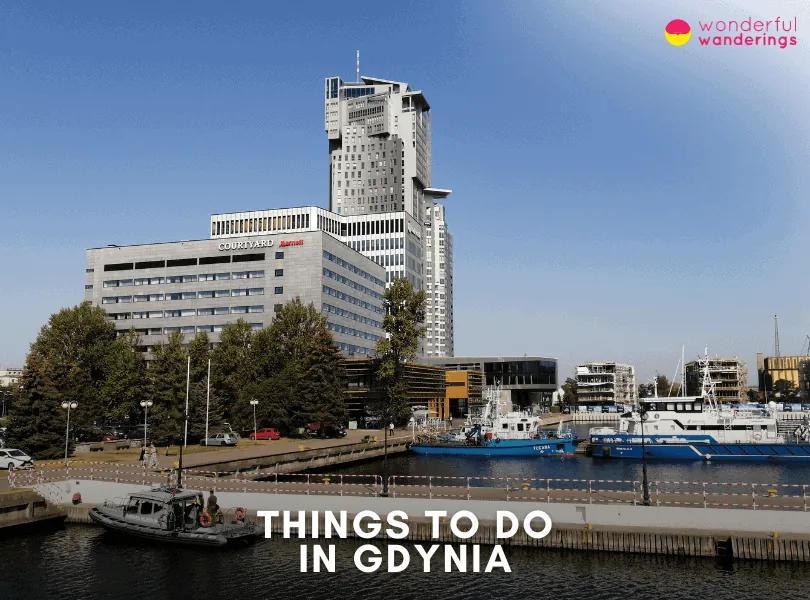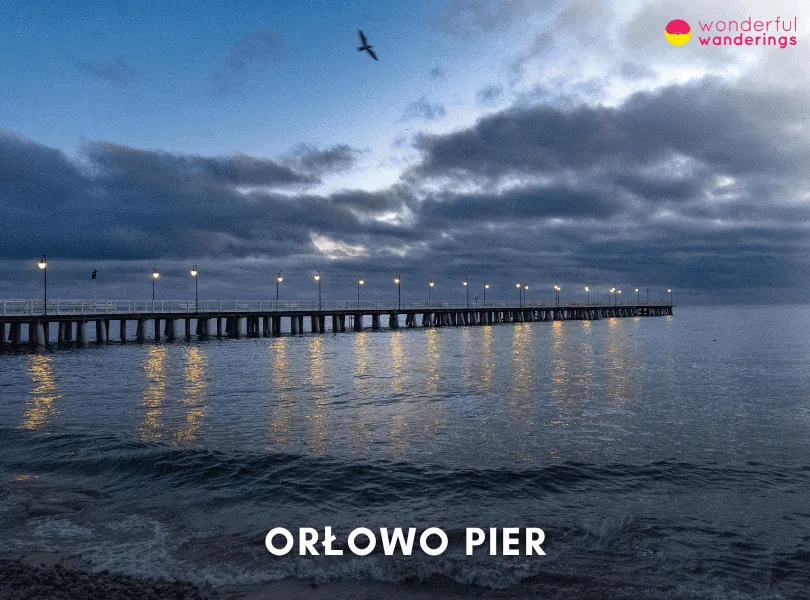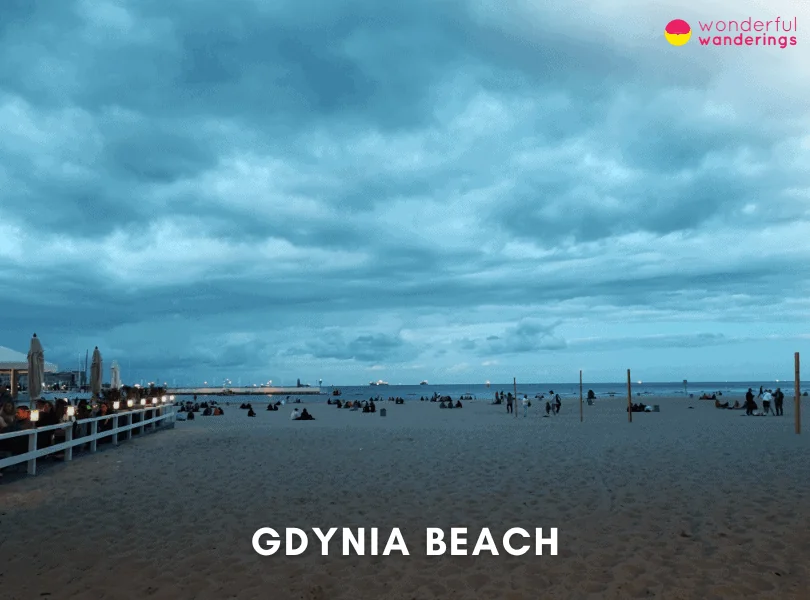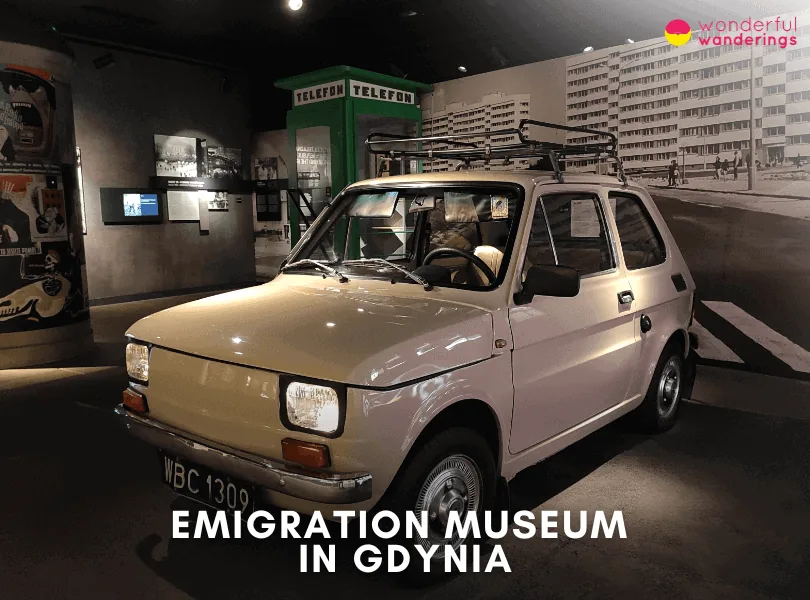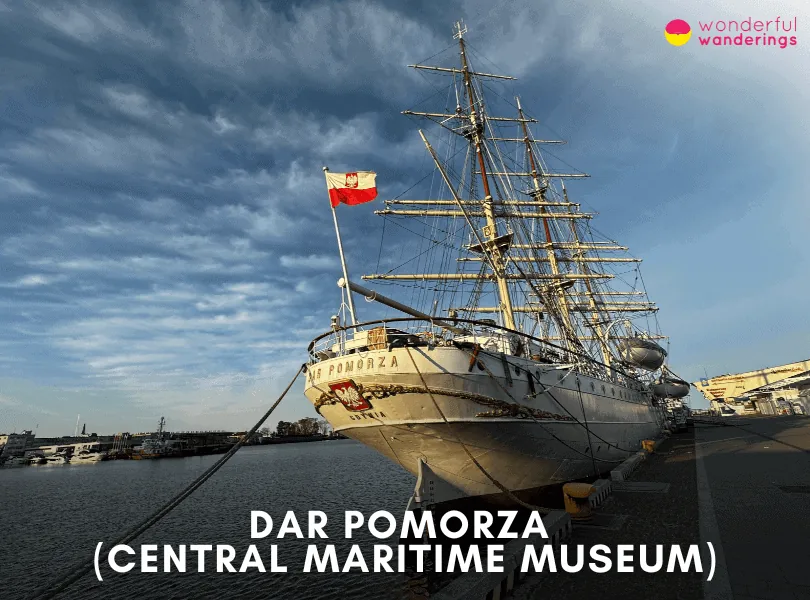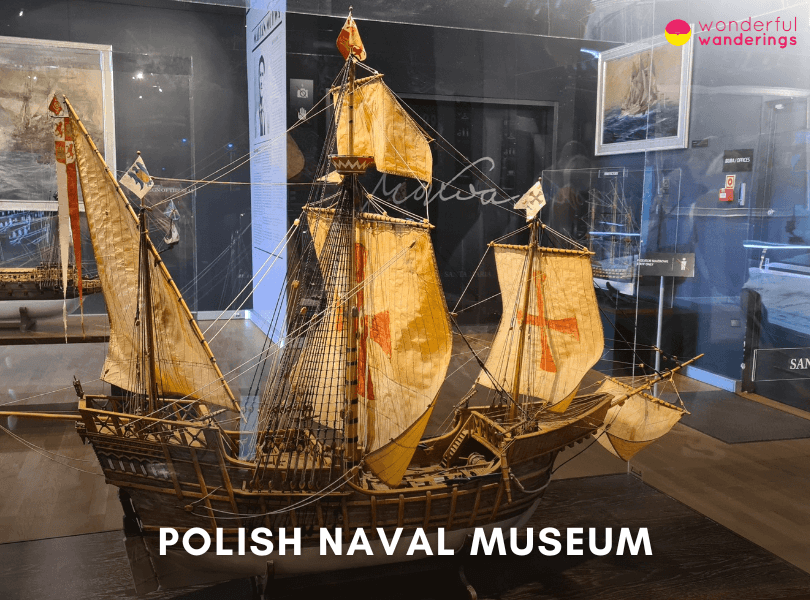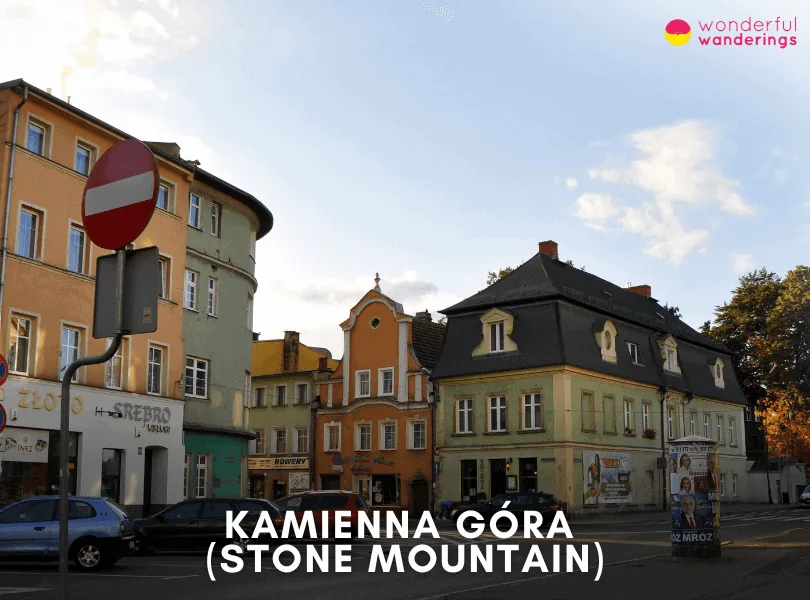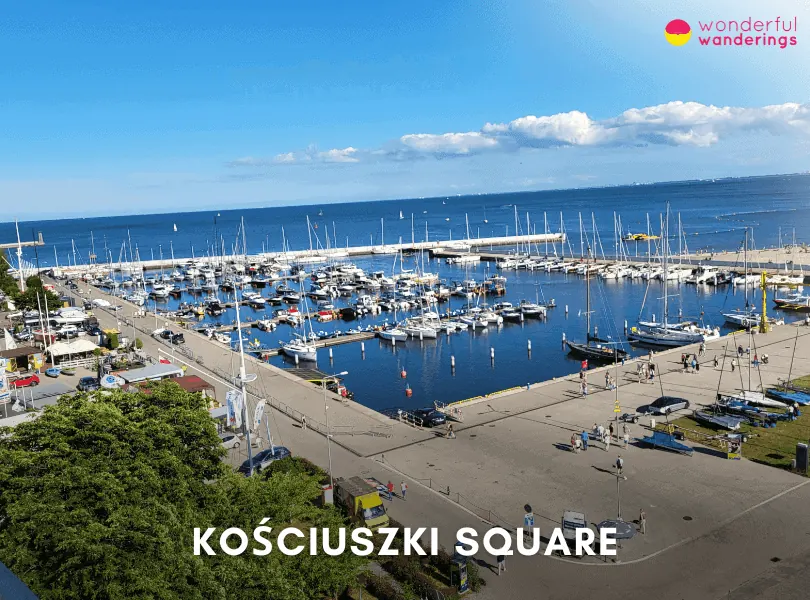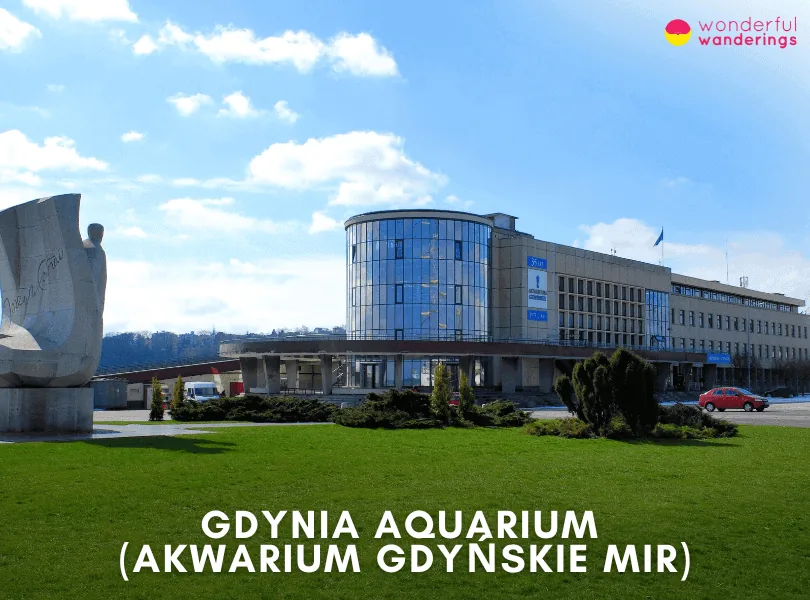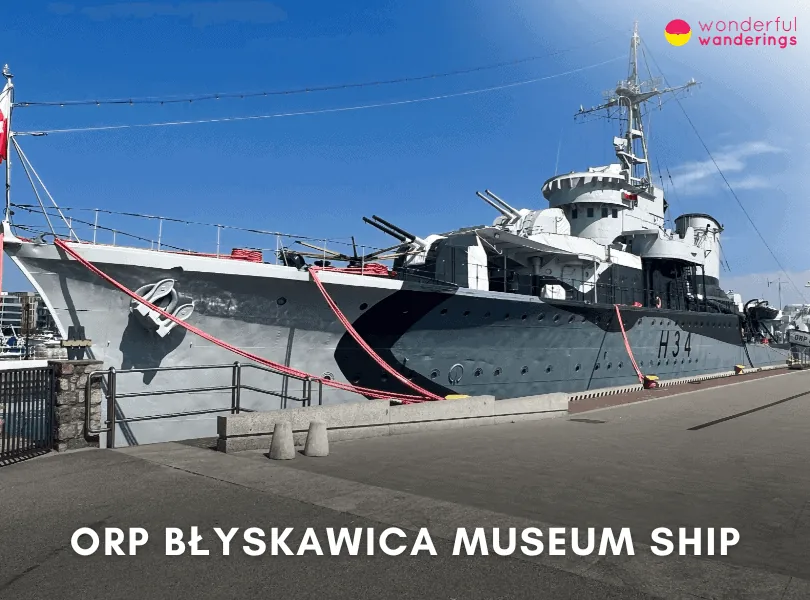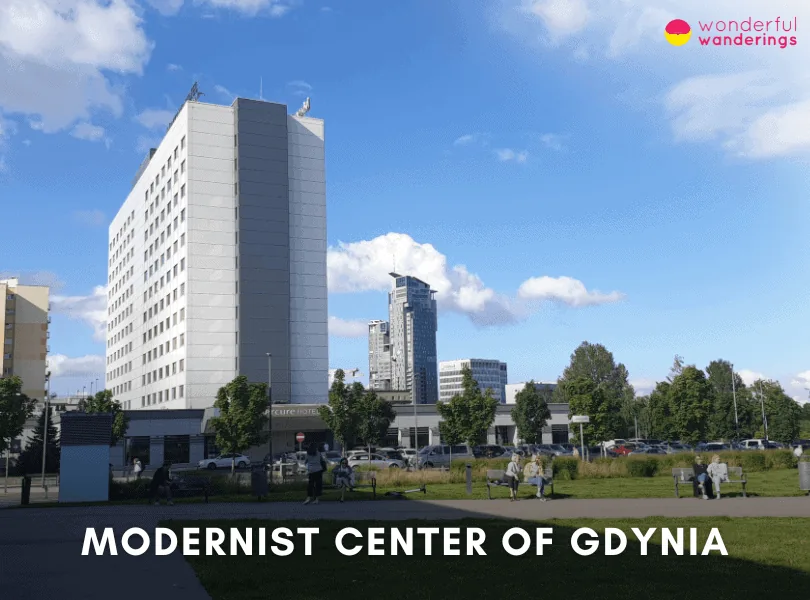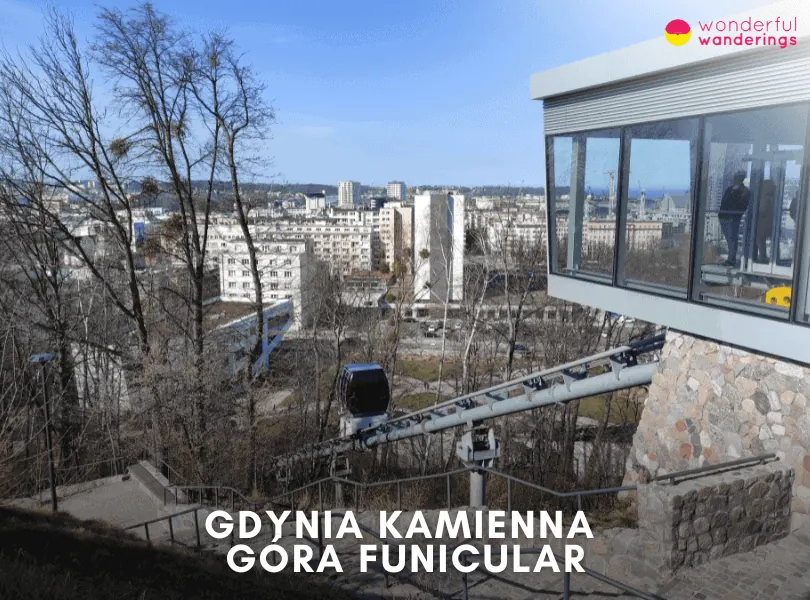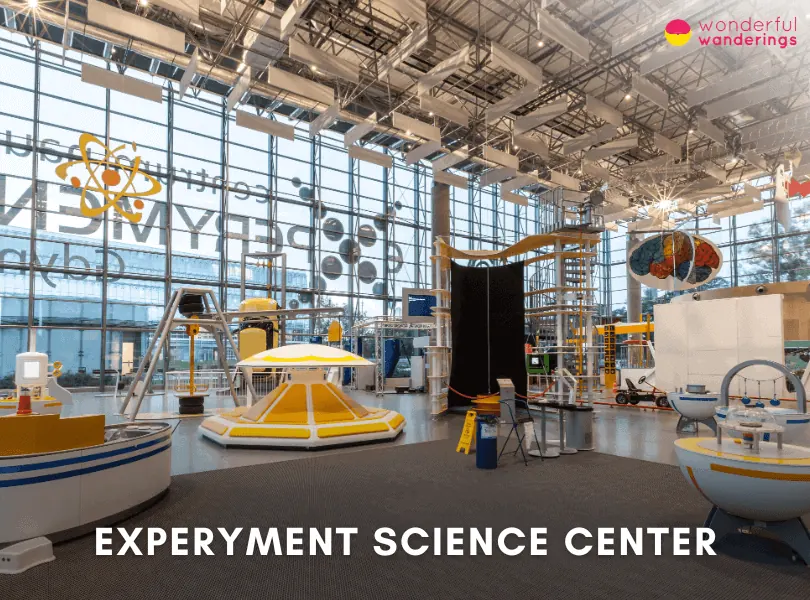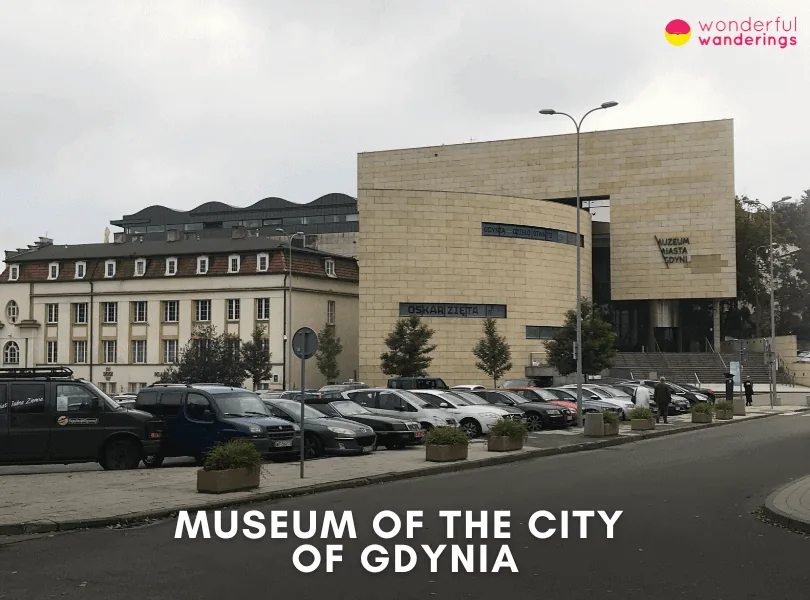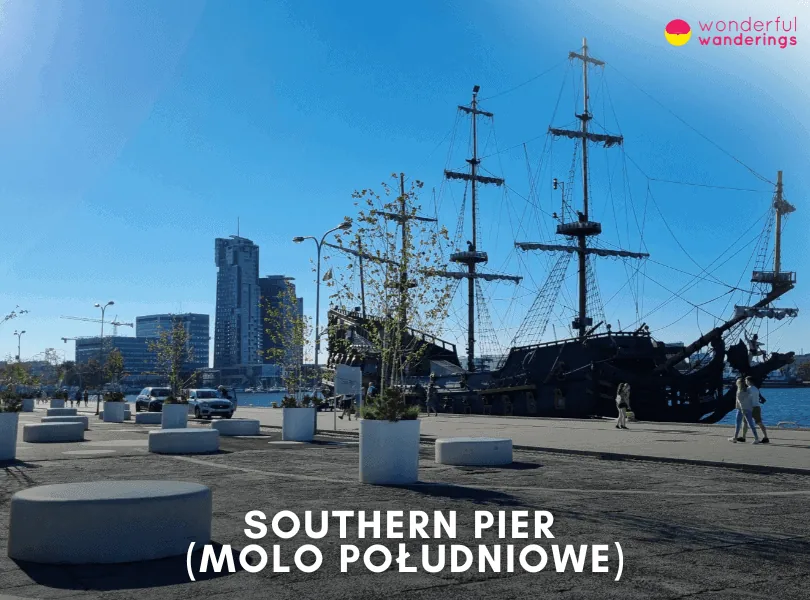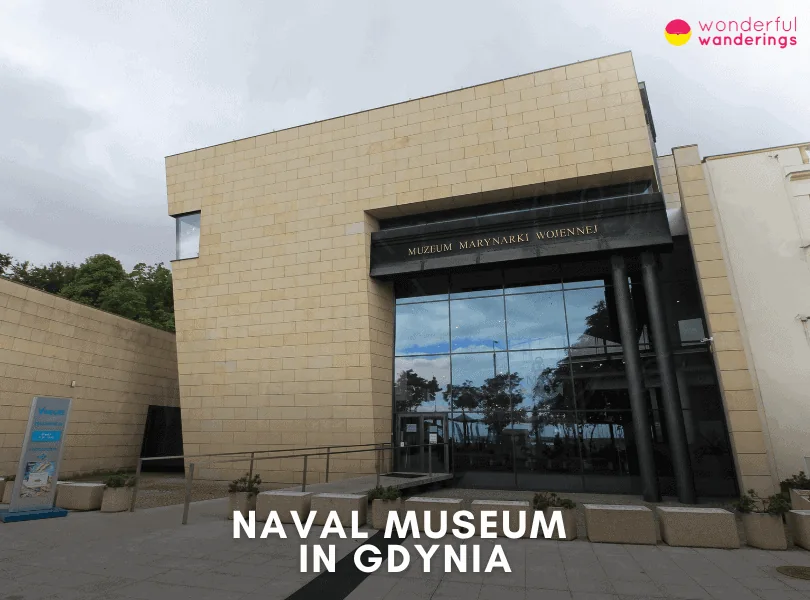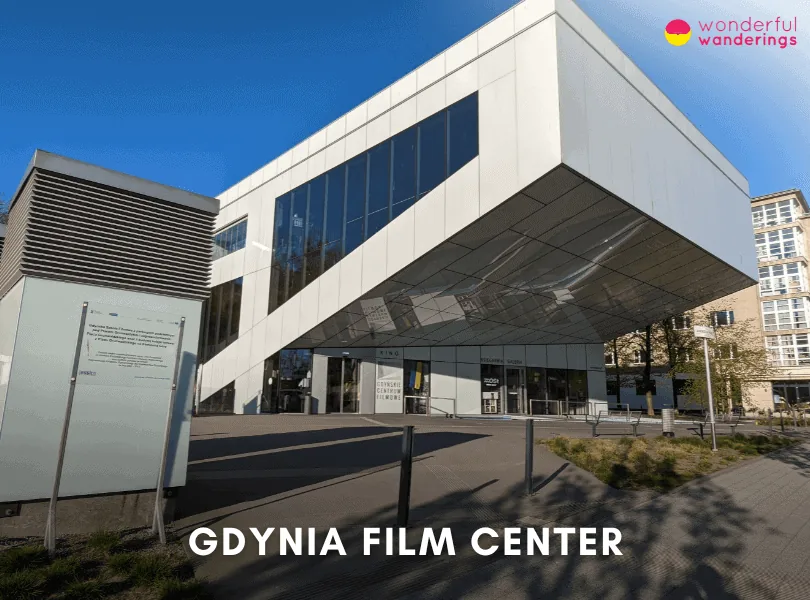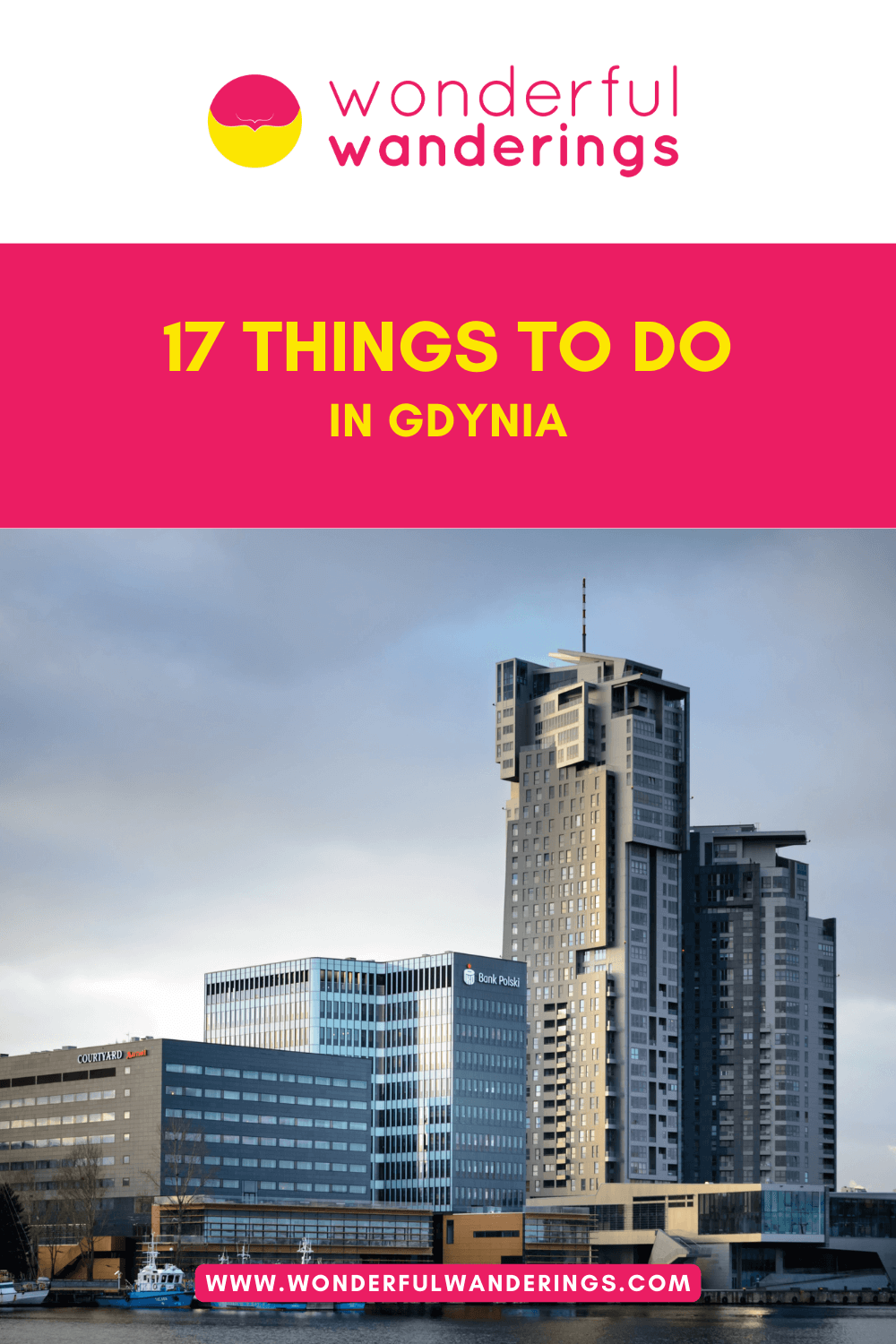Gdynia is a city in northern Poland on the Baltic Sea coast in the Pomerania region. It is part of the Tricity metropolitan area near Gdansk and Sopot. Geographically, Gdynia sits at the mouth of Gdansk Bay and is surrounded by the Kashubian Lake District landscape. It is 80 kilometers (50 miles) from the regional capital, Gdansk and 402 kilometers (250 miles) north of Warsaw. Gdynia is northern Poland’s major transportation hub and industrial center, with a population of 759,751 as of 2023.
Gdynia was a small fishing village that grew into a popular tourist resort town in the early 20th century. After Poland regained independence following World War I, the country chose Gdynia to develop as a major port city and economic hub. Construction of Gdynia’s modern port and city began in 1921. Gdynia rapidly expanded and gained city rights. Its central district showcases the 1920s-30s modernist architecture. Gdynia is northern Poland’s major transportation hub and industrial center. It is most famous for being Poland’s second-largest seaport, as a cargo, naval and passenger ship hub on the Baltic Sea. Gdynia is also known for its Emigration Museum, highlighting the city’s history of passenger travel and its modernist buildings like the PLO Headquarters.
Gdynia is a popular seaside destination, especially for its modernist central districts, sandy beaches, waterfront neighborhoods and mixed museums and attractions related to its maritime heritage. Key things to do include visiting the Emigration Museum housed in the historic port station, exploring preserved ships like Dar Pomorza and ORP Błyskawica that serve as floating nautical museums, learning about the Polish Navy’s history at the Naval Museum, strolling the Southern Pier and simply enjoying Gdynia’s seaside cafés, promenades and architecture along the Feliks Nowowiejski Seafront. Gdynia is located in the Central European Time Zone, UTC+1, one hour ahead of Greenwich Mean Time in winter. Gdynia observes daylight saving time in summer, shifting clocks forward by one hour to UTC+2.
Listed below are things to do in Gdynia.
- Orlowo Pier. Orłowo Pier is a 115-meter-long scenic wooden pier in the Orłowo district of Gdynia, Poland. It was built in 1914 and expanded in the 1920s as Orłowo became a popular beach destination. The pier features beautiful views of the sandy beaches, harbor, Orłowski Cliff and Baltic Sea. Visitors can take relaxing seaside walks, sit on benches, dine at food stands and photograph the coastal landscape. The surrounding area offers sandy beaches popular with families and hiking trails up the cliffs.
- Gdynia Beach. Gdynia Beach is a sandy public beach stretching over 200 meters along the Feliks Nowowiejski Seafront Promenade in Gdynia, Poland. Established in the early 20th century as Gdynia became a modern port city, the beach has amenities like showers, wheelchair access, lifeguard stations, volleyball courts, playgrounds and workout equipment, allowing visitors to swim, sunbathe and do beach activities year-round. The scenic coastline, seaside promenade and nearby attractions appeal to people of all ages and interests.
- Emigration Museum in Gdynia. The Emigration Museum in Gdynia, Poland, opened in 2015 to showcase the history of Polish mass economic migration abroad over 150 years. Cutting-edge interactive multimedia exhibits reconstruct environments like an ocean liner cabin and a Chicago neighborhood. The museum appeals to those interested in Polish diaspora history, cultural heritage and the universal immigrant experience, especially visitors with Polish immigrant ancestors.
- Dar Pomorza (Central Maritime Museum). The Dar Pomorza is a 1909 German-built sailing ship that served as a Polish naval training vessel from 1929-1981, taking cadets on international voyages and evacuating refugees in WWII. It is now a floating nautical museum in Gdynia, Poland, where visitors can come aboard and tour the ship to learn about its history and equipment, such as masts, sails and crew quarters. The elegant ship appeals to sailing enthusiasts, maritime history buffs and tourists seeking unique Gdynia attractions.
- Polish Naval Museum. The Polish Naval Museum in Gdynia houses over 20,000 artifacts and interactive displays chronicling Poland’s naval history over 1,000 years. Exhibitions cover naval battles, famous ships and commanders and Poland’s cooperation with Allied forces. The museum appeals to maritime and military history enthusiasts interested in learning about Poland’s naval heritage and national identity.
- Kamienna Góra (Stone Mountain). Kamienna Góra (Stone Mountain) is a 54-meter high cliff with panoramic views of Gdynia and the Baltic Sea coastline in the Kamienna Góra district of Gdynia, envisioned as an upscale resort area in the 1920s. Visitors can walk winding pathways to the hilltop observation deck, view the 25-meter cross sculpture, ride the funicular railway and enjoy scenic lookouts and eateries. The activities cater to sightseers, nature lovers, families, youth groups and photographers seeking elevated coastal perspectives.
- Kościuszki Square. Kościuszki Square is a waterfront square along Gdynia’s Southern Pier housing landmarks showcasing Gdynia’s maritime heritage like the ORP Błyskawica Museum Ship, Dar Pomorza sailing ship, Gdynia Aquarium, Polish Naval Museum and monuments honoring Pope John Paul II and port workers. Visitors can explore the ships, aquarium and museum, walk the scenic promenade, dine at seaside restaurants and access the hillside Kamienna Góra Park. The square appeals to maritime enthusiasts, families, tourists and photographers seeking sightseeing combined with seaside relaxation.
- Gdynia Aquarium. The modern Gdynia Aquarium opened in 2014 and houses over 250 aquatic species and 4,000 creatures in state-of-the-art multimedia exhibits that recreate habitats like coral reefs, kelp forests and Amazon-flooded wetlands. Visitors can get hands-on touching sharks and rays in touch pools. Interactive features like a 36-meter wall aquarium, animal feeding sessions and fishing activities provide an exciting marine life learning experience catering to visitors of all ages.
1. Orłowo Pier
Orłowo Pier (Polish. Molo w Gdyni Orłowie) is located in the coastal district of Orłowo in Gdynia, Poland, Orłowska, 81-980 Gdynia, Poland. The history of Orłowo Pier dates back to World War I when the first small pier was built in 1914-1918 to serve as both a port and seaside promenade for the nearby resort village of Orłowo. The pier was expanded in 1920 to 115 meters in length as the popularity of Orłowo grew as a beach destination.
Orłowo Pier features a seaside location tucked between the cliffs of the Orłowski Cliff and the sandy beaches of Orłowo. It is a scenic viewpoint where visitors can take in the beautiful natural landscape of mountains, sea and sky. The pier is an iconic wood structure that evokes nostalgia for the early 20th-century Baltic Coast resorts. It is also special for being more low-key than the lively commercial pier in nearby Sopot, offering a peaceful atmosphere for seaside strolls. Visitors to Orłowo Pier can take relaxing walks along the 180-meter wooden platform over the sea to view the beach, harbor and cliff. Some food and drink stands are nearby and benches to sit and gaze out over the Baltic Sea. It’s an ideal spot for photography of the panoramic coastal scenery. The surrounding area also has forest hiking trails up the Orłowski Cliff. During summer, the nearby outdoor stage hosts performances and events. The activities at Orłowo Pier are suitable for all ages but especially appealing for nature lovers, photographers, older adults, couples and those seeking tranquility by the sea. The sandy beach is also popular with families and children.
To get to Orłowo Pier, take the SKM commuter train to the Orłowo station, then walk about 1 kilometer (0,6 miles) downhill along Orłowska Street toward the sea. Orłowo district is 4 kilometers (2.4 miles) from the famous Sopot pier, making walking along the beach between the two piers possible. Entry to Orłowo Pier is free with no admission cost. It is publicly accessible to pedestrians year-round. The pier and surrounding area offer a delightful glimpse into Poland’s Baltic coast for a refreshing seaside getaway without the bigger crowds.
2. Gdynia Beach
Gdynia Beach (Polish. Plaża Gdynia) is located in the city of Gdynia along Poland’s Baltic Sea coast, Bulwar Nadmorski, 81-374 Gdynia, Poland. The history of Gdynia Beach dates back to the early 20th century when Gdynia transformed from a small fishing village into a modern port city. As the city grew into a popular seaside destination in the 1920s and 1930s, the coastline was developed into an attractive public beach stretching over 200 meters long just steps from the city center. Gdynia Beach is considered one of Poland’s most beautiful and well-equipped beaches.
Gdynia Beach features a city-center location coupled with a scenic natural landscape. It lies right along the Feliks Nowowiejski Seafront Promenade, with views across the Gulf of Gdańsk showcasing the harbor, marina and seaside cliffs. The golden sandy beach has modern amenities like showers, changing rooms and wheelchair accessibility while retaining a peaceful, relaxing atmosphere. Visitors to Gdynia Beach can swim, sunbathe, do beach sports and take seaside walks at any time of year. There is a designated swimming area with lifeguards on duty in summer. Beach volleyball courts, play areas for children and outdoor workout equipment allow for active recreation. The nearby promenade is excellent for picturesque strolls and cycling, with benches for the coastal scenery. When hunger strikes, there are a few seasonal snack bars and Port Browar Gdynia, a beachfront brewpub restaurant.
The activities at Gdynia Beach cater to people of all ages and interests, families, couples, groups of friends and solo travelers. It offers just enough to keep kids entertained between swimming and sandcastle building without being overcrowded.
Getting to Gdynia Beach is convenient by public transportation or car. From Gdynia Główna train station, take bus #119, #147 or #517 directly to the Przystanek Muzeum Emigracji bus stop next to the beach. If driving, parking lots are found along the Seafront Promenade. The beach is also within walking distance of downtown Gdynia accommodations and attractions.
Entry and access to Gdynia Beach are free and open to the public year-round. Its sandy shoreline and seaside location offer visitors an enjoyable getaway during any season while highlighting Gdynia’s natural coastal beauty.
3. Emigration Museum in Gdynia
The Emigration Museum (Polish. Muzeum Emigracji) is located at ul. Polska 1 in Gdynia, Poland. The history of the Emigration Museum dates back to the interwar period when Gdynia was a major port for Polish emigrants leaving for America. An Emigration Bureau was established in Gdynia in the 1930s to assist emigrants. This history inspired the creation of a museum dedicated to the Polish diaspora and emigration experience. The Emigration Museum opened on September 28, 2015, in a modern waterfront building designed to resemble a ship.
The Emigration Museum is an interactive, cutting-edge approach to presenting the history of Polish emigration and the immigrant experience. State-of-the-art multimedia technology brings to life over 150 years of mass economic migration from Poland to destinations like America, Brazil, France and Germany. The museum’s core exhibition spans three floors with visual effects, ambient sounds, archival film footage, oral histories and nearly 1,500 artifacts chronicling Polish emigrants’ hopes, struggles and cultural contributions abroad.
Visitors to the Emigration Museum can explore room-sized multimedia installations that reconstruct environments like an ocean liner cabin, immigrant train car, Latin American hacienda, French metro station and a Chicago neighborhood. The interactive exhibits and immersive environments at the Emigration Museum appeal most to adults and youth interested in Polish history, cultural heritage and the universal immigrant experience. It is also worthwhile for those with Polish immigrant ancestry seeking to reconnect with their roots. The museum experience sparks intergenerational conversations between children, parents and grandparents around family migration stories.
The Emigration Museum is easily accessible by public transportation or car. From the Gdynia Główna train station, take bus #119, 147, or 517 directly to the Muzeum Emigracji stop. Entry tickets to the permanent and temporary exhibitions at the Emigration Museum cost 25 PLN (10€, $11, £8) per adult. Free admission every Monday is offered between October and May. Guided tours in foreign languages require advanced reservations for groups.
4. Dar Pomorza (Central Maritime Museum)
The Dar Pomorza is a historic Polish sailing ship and museum located at Al. Jana Pawła II 1 in Gdynia, Poland. The history of Dar Pomorza dates back to 1909, when it was built in Hamburg, Germany, as a German sailing ship called Prinzess Eitel Friedrich. It was used as a training ship by the German Navy. After World War I ended, the ship was taken by France as war reparations and renamed Duchesse Anne. In 1929, Poland purchased and rechristened the ship Dar Pomorza, which means “Gift of Pomerania”.
Dar Pomorza served as a Polish naval training ship. It took cadets on long international voyages to countries like Australia, India and America. During World War II, the ship evacuated Polish refugees to Britain. After the war, Dar Pomorza resumed its original role as a training vessel until the 1980s, when it became a floating branch of Gdynia’s Central Maritime Museum. Dar Pomorza stands as one of the oldest preserved sailing ships in the world. As a museum, visitors can come aboard Dar Pomorza to experience sailing history firsthand and admire the elegant beauty of a bygone Age of Sail. Visitors to Dar Pomorza can tour the entire ship to view and learn about its construction and equipment. It has three tall masts, 15 sails, wooden decks, officers’ quarters, cadet dormitories, an engine room and more. The Dar Pomorza appeals most to maritime history and sailing enthusiasts, adults and youth interested in 20th-century Polish and World War II history, nautical architecture buffs, photographers and tourists seeking unique attractions in Gdynia beyond the beach. The ship has accessibility options for visitors with disabilities.
Dar Pomorza is located along Gdynia’s attractive waterfront downtown area, surrounded by shops, restaurants and hotels. It is easily accessible by public transportation or car. From Gdynia Główna train station, take bus #119, 147 or 517 directly to the Dar Pomorza bus stop.
Entry tickets to tour the Dar Pomorza cost 10 PLN (2€, $2, £1) per adult. Discounted tickets are available for youth under 26, students, seniors over 60, and families. Guided tours are offered in Polish, though informational displays have English translations. The option to sail on Dar Pomorza must be reserved in advance.
5. Polish Naval Museum
The Polish Naval Museum (Polish. Muzeum Marynarki Wojennej) is located at ul. Zawiszy Czarnego 1B in Gdynia, Poland. The history of the Polish Naval Museum dates back to the interwar period after Poland regained independence in 1918. The Polish Navy was re-established with its main base in Gdynia and then a new seaport was under construction. In 1921, an Exhibition of the Navy and Merchant Fleet was organized in Gdynia. This modest display of Polish maritime history laid the early foundations of the Naval Museum. Its current modern building opened on September 15, 1977.
Polish Naval Museum artifacts, photos, documents and naval equipment bring to life Poland’s rich maritime legacy over 1,000 years, showcasing famous naval battles, ships, commanders and Allied cooperation. The impressive museum collection counts over 20,000 items. Visitors to the Polish Naval Museum can explore several permanent interactive exhibitions spanning two floors. The displays chronologically cover Poland’s naval history, including the Medieval ships that ruled the Baltic Sea, the Polish-Lithuanian Navy, the establishment of the Polish Navy in the Second Republic, World War II naval warfare and Poland’s postwar People’s Navy. The Polish Naval Museum appeals to maritime history buffs and military enthusiasts of all ages interested in learning about Poland’s naval heritage. It is worthwhile for tourists to delve deeper into Polish history beyond the well-known sites. The museum experience sparks multi-generational conversations around national identity.
The Polish Naval Museum is easily accessible by public transportation or car. From Gdynia Główna train station, take bus #119, 147, or 517 directly to the Muzeum Marynarki Wojennej bus stop by the museum entrance. Entry tickets to the Polish Naval Museum cost 10 PLN (2€, $2, £1) per adult. Guided tour reservations must be made in advance for groups. Free admission is offered on Sundays.
6. Kamienna Góra (Stone Mountain)
Kamienna Góra (Stone Mountain) is in the Kamienna Góra district of Gdynia at 10 Lutego 24, 81-547 Poland. The history of Kamienna Góra dates back to the early 20th century when it was envisioned as an upscale resort area in the new city of Gdynia. Its name, “Stone Mountain”, comes from the steep 54-meter high cliff overlooking the sea. An upper-class villa district and seaside promenade were developed at the foot of the hill in the 1920s and 30s. During World War II, Kamienna Góra was the site of fighting to defend the city. It is considered one of Gdynia’s most exclusive neighborhoods and a popular lookout point.
Kamienna Góra features panoramic views of Gdynia, the Gulf of Gdańsk and the Baltic Sea coastline. The hill is an iconic landmark with winding pathways, gardens and a 25-meter-high steel cross sculpture built in 1976. The nearby funicular railway and quaint villas add old-world charm. Visitors to Kamienna Góra can take relaxing walks along the pathways to enjoy the scenery, picnic on the hillside lawns and take photos of the panorama and giant cross. The observation deck offers scenic lookouts over the city through telescopes. There are also a few eateries and souvenir shops near the top. The funicular train provides easy access up and down the cliff for sightseeing. The park areas at the base of the hill offer pleasant strolls and events in summer. The activities at Kamienna Góra cater to all ages but have special appeal for sightseers, nature lovers, photographers, families, youth groups and religious visitors who come to see the monumental cross. The hilltop vantage point and funicular train make it easily accessible for seniors and those with limited mobility.
Getting to Kamienna Góra is convenient by public transport or car. From Gdynia Główna train station, take bus #147, 168, or 519 directly to the Kamienna Góra bus stop at the funicular lower station. Entry and access to Kamienna Góra Park are free and open to the public year-round. Riding the funicular train to the top costs 4 PLN (1€, $1, £0.86) per person. The natural scenery and views from Stone Mountain offer visitors a beautiful elevated perspective on Gdynia and the Baltic coast.
7. Kościuszki Square
Kościuszki Square (Polish. Skwer Kościuszki) is located in downtown Gdynia, Poland, along the city’s waterfront. The history of Kościuszki Square dates back to the interwar period when Gdynia was rapidly developing into a modern port city and seaside resort. The square was named after Polish and American revolutionary hero Tadeusz Kościuszko.
Kościuszki Square features a waterfront setting and a collection of landmarks exemplifying Gdynia’s maritime heritage. The ORP Błyskawica Museum Ship and Dar Pomorza sailing ship are docked along the Southern Pier jutting from the square. There is also the Gdynia Aquarium, the Polish Naval Museum and monuments honoring Pope John Paul II, the Polish sailor and the Gdynia port workers. Visitors to Kościuszki Square can explore the historic ships, Gdynia Aquarium and Naval Museum. The Southern Pier offers a scenic seaside promenade out to the marina breakwater. There are places to eat and drink around the square, with benches, lawns and a musical fountain. The hillside park leading to Kamienna Góra has wooded walking paths overlooking the harbor. The square surroundings tempt visitors with shops, restaurants and attractions. The activities at Kościuszki Square have broad appeal but especially cater to maritime enthusiasts, families, tourists, photography buffs and those looking for sightseeing combined with seaside relaxation.
Getting to Kościuszki Square is convenient by public transportation or car. From Gdynia Główna train station, take bus #119, 147 or 517 directly to the Skwer Kościuszki bus stop by the ORP Błyskawica ship. Entry and access to Kościuszki Square is free and open 24/7. The square offers visitors an enjoyable hub to experience Gdynia’s rich maritime atmosphere and relaxing seaside location.
8. Gdynia Aquarium (Akwarium Gdyńskie MIR)
The Gdynia Aquarium (Polish. Akwarium Gdyńskie MIR) is located at al. Jana Pawła II 1 in Gdynia, Poland. The history of the Gdynia Aquarium dates back to 1971 when a small 25-tank exhibit first opened near the Southern Pier as the Seaside Aquarium. After renovations and expansions over the years, the aquarium moved to its current modern location along the waterfront in Gdynia city center in 2014. The new eco-friendly building was designed to showcase freshwater and marine life from Poland and worldwide.
Gdynia Aquarium features a cutting-edge interactive approach, bringing visitors face-to-face with over 250 species and 4,000 animal specimens. State-of-the-art multimedia displays recreate diverse aquatic habitats from tropical coral reefs to Antarctic waters to Amazon-flooded forests. The aquarium features the world’s longest interactive wall aquarium at 36 meters long. Visitors can touch sharks, rays, sea stars and anemones in the touch pools. The oceanarium even offers fishing opportunities with sharks or feeding penguins and otters. Visitors to the Gdynia Aquarium can explore over a dozen tanks and terrariums showcasing creatures like sharks, rays, moray eels, sea turtles, octopuses, crocodiles, giant snakes, tiny poison dart frogs and piranhas. The Gdynia Aquarium appeals to visitors of all ages, especially families with kids, school groups, animal lovers, photographers and tourists seeking indoor attractions. Its interactive approach makes learning about the marine world exciting. The nearby Southern Pier, beach and Science Discovery Centre appeal to families.
The aquarium’s convenient downtown location allows easy public transport or car access. From Gdynia Główna train station, take bus #119, 147, or 517 directly to the Akwareum Gdyńskie MIR bus stop by the entrance. Entry tickets to the Gdynia Aquarium exhibit cost 35 PLN (8€, $8, £6) for adults and 25 PLN for youth ages 5-16. Discounted tickets are available for families, students, seniors 60+, and disabled visitors. Combo tickets include the neighboring Experiment Science Centre. Guided tours in English must be booked in advance for groups.
9. ORP Błyskawica museum ship
The ORP Błyskawica museum ship is at al. Jana Pawła II 1 in Gdynia, Poland. The history of ORP Błyskawica dates back to its construction as a Grom-class destroyer for the Polish Navy in 1935-1937. It went on to serve Poland bravely in World War II, earning distinction as the only naval vessel decorated with the Virtuti Militari, Poland’s highest military order for gallantry. Błyskawica returned to communist Poland and continued naval service until 1976, when it was decommissioned and converted into a museum ship.
Błyskawica highlights the remarkable survival over 70+ years and a storied fighting record under three different navies. Visitors to Błyskawica can tour the destroyer to learn about its construction, weaponry, engines, officers’ quarters and more. Guests can climb narrow stairs to reach the helm and upper deck for panoramic views of the harbor. The onboard exhibit highlights artifacts, photos, documents and films about its wartime service and the Polish diaspora at sea. Occasionally, Błyskawica offers short sails around Gdynia for an additional cost. The ship museum appeals most to maritime history enthusiasts, military buffs, photography hobbyists, tourists seeking unique attractions in Gdynia beyond the beach and Poles connecting with their heritage. The outdoor viewing terrace and accessibility options also suit seniors and visitors with disabilities.
Błyskawica is conveniently located downtown along Gdynia’s attractive waterfront, surrounded by shops, restaurants, and hotels. From Gdynia Główna train station, take bus #119, 147, or 517 directly to the ORP Błyskawica bus stop. The museum ship is also within walking distance of city center accommodations. Entry tickets to tour ORP Błyskawica cost 10 PLN (2€, $2, £1). Discounted tickets are available for youth under 26 years, students, seniors over 60, and families. Guided tour reservations in English or German must be arranged in advance for groups.
10. Modernist Center of Gdynia
The Modernist Center of Gdynia is in the Śródmieście district of Gdynia, Poland, 81-370 Gdynia, Poland. The history of the Modernist Center of Gdynia dates back to the interwar period when Gdynia was rapidly developing into a modern port city and seaside resort after Poland regained independence. Gdynia’s city center was established mainly in the 1920s and 1930s when the city grew from a small fishing village into a major economic hub. The character and architecture of the city center were largely shaped by architects like Adam Kuncewicz, Barbara Brukalska and Stefan Bryła, who embraced Modernism.
The Modernist Center of Gdynia has an urban complex exemplifying early 20th-century Modernism. The orthogonal street grid, planned city zoning, innovative housing and functionalist buildings emphasize efficiency while allowing light and sea views. The Southern Pier and shoreline buildings symbolize Gdynia’s connection to the world through port and ocean travel. Visitors can explore the modernist architecture along major streets like 10 Lutego, Świętojańska and Jana Pawła II Avenue. Key attractions include the Southern Pier’s iconic 1935 transatlantic liner terminal, Modernist landmarks like the 1936 Polish Ocean Lines building and various examples of ship-inspired interwar housing. The area also features institutions like the National Maritime Museum, the Emigration Museum and the Maritime University. The Modernist Center of Gdynia appeals to sightseers, architecture enthusiasts, city tourists, maritime history buffs and those seeking stylish urban landscapes. Its seaside location and mix of buildings make it attractive for all ages.
The Modernist district is located in central Gdynia and is easily accessible by public transport like trains, buses or trams. Entry and access to the streets and parks of Gdynia’s Modernist Center district are free and open to the public year-round. Entire attractions like the Emigration Museum, Southern Pier terminal and historic ships have separate fees.
11. Gdynia Kamienna Góra Funicular
The Gdynia Kamienna Góra Funicular (Polish. Kolejka na Kamienną Górę) is located at Plac Grunwaldzki in the Kamienna Góra district of Gdynia. The history of the Kamienna Góra Funicular dates back to 2015 as part of the city’s initiative to make the scenic 52-meter-tall Kamienna Góra (Stone Mountain) more accessible. A funicular system with modern glass gondolas was constructed to transport visitors up and down the steep hillside. The lower funicular station is next to the Gdynia Film Centre on the newly renovated Grunwald Square, which opened in July 2015.
The Kamienna Góra Funicular provides convenience and scenic nature. The funicular allows easy access to the top of Kamienna Góra, which offers stunning panoramic views of Gdynia, the Gdańsk Bay and the Baltic Sea coastline. The modern glass-enclosed gondola ascends 40 meters over 96 meters along the wooded hillside in 120 seconds, providing a unique city perspective. Visitors can ride the funicular to experience quick and effortless access to the top of Kamienna Góra. The hilltop offers a perfect spot for photos with its panoramic vistas. The funicular accommodates all ages and abilities but has special appeal for families, seniors, photographers, sightseers and those with limited mobility. The gondola fits 12 passengers and has buttons for self-operation and wheelchair accessibility. The area also draws youth groups, couples and religious visitors to see the monumental cross.
Getting to the Kamienna Góra Funicular is convenient by public transport or car. From Gdynia Główna train station, take bus #147, 168 or 519 directly to the Kamienna Góra bus stop.
Riding the Kamienna Góra Funicular is completely free of charge and open daily. It provides easy access up the Stone Mountain to take in beautiful elevated views and seaside landscapes unique to Gdynia.
12. Experyment Science Center
The Experyment Science Center (Polish. Centrum Nauki Experyment) is at Aleja Zwycięstwa 96/98 in Gdynia, Poland. The history of the Experyment Science Center dates back to its establishment in 2007 as one of Poland’s first interactive science centers. It started as a modest 500-square-meter exhibition affiliated with the Gdynia Innovation Centre before moving to its modern 3,500-square-meter headquarters in 2013 after major expansions. The ultramodern building combines interactive science exhibits with conference facilities.
The Experyment Science Center’s specialty is its hands-on educational philosophy of “learning through fun” for visitors of all ages. It features over 200 interactive stations and exhibits focused on igniting curiosity and fascination with various scientific phenomena. The center contains five permanent exhibition zones. “Hydroworld” (water), “Tree of Life” (nature and animals), “Operation. Human” (anatomy and health), “Invisible Forces” (physics) and “Towards Health” (wellness). State-of-the-art multimedia visually recreates the science concepts using games, experiments, simulations and activities. Exhibits allow guests to conduct hands-on experiments like manipulating water dynamics, studying wildlife, building electrical circuits, exploring optical illusions or viewing their virtual future selves. The science center appeals most to curious minds of all ages, especially families with school-age children, student groups, summer camps and amateur science buffs looking to engage with STEM topics playfully. The exhibits and activities spark imagination and provide a lively learning environment beyond the traditional classroom.
Getting to the Experyment Science Center is convenient by public transport or car. From Gdynia Główna train station, take bus #119, 147, or 517 directly to the Centrum Nauki Experyment bus stop. Entry tickets to the interactive Experyment exhibitions cost 20 PLN (5€, $5, £3). The science center is closed on Mondays except during the peak summer season.
13. Cliff in Kępa Redłowska Nature Reserve
The Cliff in Kępa Redłowska Nature Reserve is located in the coastal Kępa Redłowska district of Gdynia, Redłowska, 81-547 Gdynia, Poland. The history of the Cliff in Kępa Redłowska dates back to the interwar period when the area was envisioned as an upscale seaside resort village in the new city of Gdynia. “Stone Headland” refers to the steep 50-meter high cliff overlooking the Gulf of Gdańsk along the coastline.
The Cliff in Kępa Redłowska offers spectacular views of the sea, cityscape and surrounding landscapes that showcase the natural beauty for which Gdynia is known. The cliff is an iconic landmark with its multi-layered geological strata, now protected as part of Poland’s first nature reserve. Visitors to the Cliff can walk along designated trails through the Kępa Redłowska reserve to view the cliff erosion, sea coast and rich forest habitat. An observation deck atop the cliff provides panoramic vistas across the bay. The sandy beach below the cliff is popular for swimming in summer. Walking routes wind through the lush hillside park leading up to Kamienna Góra. The cliff and nature reserve activities cater to outdoor enthusiasts of all ages – nature lovers, bird watchers, geology buffs and photographers. The sandy beach also appeals to families with kids. And history connoisseurs appreciate remnants of wartime fortifications.
Getting to the Kępa Redłowska Nature Reserve is convenient by car or public transport. From Gdynia Główna train station, take bus #119, 147 or 517 to the Kępa Redłowska stop. Entry and access to the Kępa Redłowska Nature Reserve are free and open to the public year-round to respectfully explore the natural habitat and cliff landscape during designated visiting hours. Guided tours require reservations.
14. Museum of the City of Gdynia
The Museum of the City of Gdynia (Polish. Muzeum Miasta Gdyni) is located at ul. Zawiszy Czarnego 1A in Gdynia, Poland. The history of the Gdynia City Museum dates back to the 1960s when establishing a municipal museum was proposed to document and showcase Gdynia’s rapid development in the 20th century from a fishing village to a modern port city.
The Museums of the City of Gdynia have an extensive and diverse collection of over 50,000 artifacts documenting the city’s rich history. Photographs, documents, artworks, everyday objects and interactive displays provide a glimpse into the past lives of Gdynia residents and the growth of this iconic port city through periods of autonomy, war, communism and democratic Poland. The museum’s ship-inspired architecture also symbolizes Gdynia’s maritime identity. Visitors to the Museum can explore several floors of multimedia exhibits and scenic views of the harbor that chronologically trace Gdynia’s evolution in the 20th century. There are visual reconstructions of the cityscape, port infrastructure and major events over time. The museum also displays artifacts related to famous Gdynia figures, cultural heritage, architectural development and transformation into a modern metropolis. The museum appeals to visitors of all ages, especially those interested in regional history, Gdynia culture, Polish modernization, urban development and port-city landscapes. Interactive stations make learning exciting for youth. The waterfront location offers sightseeing opportunities to combine with seaside relaxation.
Getting to the Gdynia City Museum is convenient by public transport or car. It sits downtown right along the attractive harbor boardwalk. From Gdynia Główna train station, take bus #119, 147, or 517 to the Muzeum Miasta Gdyni stop. Entry tickets to the Gdynia City Museum’s permanent and temporary exhibitions cost 15 PLN (3€, $3, £2). Discounted tickets are available for seniors 60+, students, children under 18, and families. The museum is closed on Mondays, but free admission is offered on Tuesdays.
15. Southern Pier (Molo Południowe)
The Southern Pier (Polish. Molo Południowe) is located at al. Jana Pawła II in Gdynia, Aleja Jana Pawła II 1, 81-345 Poland. The history of the Southern Pier dates back to 1933 and 1936 when it was constructed to expand the port of Gdynia during the city’s rapid interwar development. Built on an artificial peninsula jutting 530 meters into the Gulf of Gdańsk, the pier was designed in Modernist architectural style with functionalist buildings. It was rebuilt and renovated over the years to continue serving as a passenger terminal, marina harbor and scenic seaside promenade.
The Southern Pier features a waterfront location, striking 1930s design and landmarks exemplifying Gdynia’s maritime heritage. Historic ships like ORP Błyskawica and Dar Pomorza are docked along the pier. The Gdynia Aquarium, National Maritime Museum and Sea Towers skyscrapers provide an attractive surrounding backdrop overlooking the harbor. Visitors to the Southern Pier can walk the 530-meter wooden platform out into the Gulf of Gdańsk to take in panoramic views of ships, ferries, the beach and cliffsides. The modernist Southern Pier Terminal building at the base of the pier houses the Emigration Museum. The seaside promenade activities appeal to sightseers of all ages; tourists, photographers, families, couples and seniors can enjoy the scenic views and attractions equally.
The Southern Pier is conveniently located in Gdynia city center along the downtown waterfront. It is easily accessible by public transport – from Gdynia Główna train station, take bus #119, 147 or 517 to the Molo Południowe bus stop. Entry and access to the Southern Pier structure are free and open to the public year-round.
16. Naval Museum in Gdynia
The Naval Museum in Gdynia (Polish. Muzeum Marynarki Wojennej) is located at ul. Zawiszy Czarnego 1B in Gdynia, Poland. The history of the Naval Museum dates back to the interwar period after Poland regained independence in 1918. The Polish Navy was re-established with its main base in Gdynia, then a new seaport under construction. In 1921, an Exhibition of the Navy and Merchant Fleet was organized in Gdynia. This museum display of Polish maritime history laid the early foundations of the Naval Museum. Its current modern building opened on September 15, 1977.
The Naval Museum special is its extensive collection tracing the history and traditions of the Polish Navy from the Middle Ages to the present day. The museum’s artifacts, photos, documents and naval equipment bring to life Poland’s rich maritime legacy over 1,000 years, showcasing famous naval battles, ships, commanders and Allied cooperation. The impressive museum collection counts over 20,000 items. Visitors to the Naval Museum can explore several permanent interactive exhibitions spanning two floors. The displays chronologically cover Poland’s naval history, including the Medieval ships that ruled the Baltic Sea, the Polish-Lithuanian Navy, the establishment of the Polish Navy in the Second Republic, World War II naval warfare and Poland’s postwar People’s Navy. The museum also exhibits uniforms, nautical instruments, artillery, ship models, paintings and films. The upper floor features the inside of a real minelayer ship, the ORP Gryf. The Naval Museum appeals to maritime history buffs and military enthusiasts of all ages interested in learning about Poland’s naval heritage. It is worthwhile for tourists to delve deeper into Polish history beyond the well-known sites.
The Naval Museum is located along Gdynia’s attractive waterfront downtown area, surrounded by shops, restaurants and hotels. It is easily accessible by public transportation or car. From Gdynia Główna train station, take bus #119, 147 or 517 directly to the Muzeum Marynarki Wojennej bus stop by the museum entrance. Entry tickets to the Naval Museum cost 10 PLN ($2, 2€, 1£). Guided tour reservations must be made in advance for groups. Free admission is offered on Sundays.
17. Gdynia Film Center
The Gdynia Film Center (Polish. Gdyńskie Centrum Filmowe) is in downtown Gdynia at Plac Grunwaldzki 2, 81-372 Poland. The history of the Gdynia Film Center dates back to 2015 when it opened as a modern hub for film culture and education in the city’s heart. Creating an architecturally striking facility to consolidate these film activities marked a milestone in Gdynia’s cultural development.
The Gdynia Film Center special is its multifunctional role as an arts venue focused on quality cinema. It contains a 3-screen arthouse cinema showing the best Polish and international films, the Gdynia Film School, an art gallery space, a museum shop, a cafe, a restaurant and an underground parking garage. The center hosts film festivals, workshops, exhibitions and discussions with luminaries from the film world. Visitors to the Gdynia Film Center can see screenings of highly acclaimed movies in the cinema, admire photography displays in the gallery, browse books and film souvenirs in the shop, enjoy meals in the cafe or restaurant and participate in special film events. Budding directors can enroll in courses at the Gdynia Film School. Frequent special events include appearances by directors, actors and other VIP guests connected with the center’s screenings and programs. The film school attracts aspiring filmmakers. The seaside site makes it attractive to combine with sightseeing. The center aims to promote film culture as an entertainment and art form, bringing together enthusiasts and professionals.
The Gdynia Film Center enjoys a convenient downtown location by the city’s waterfront, within walking distance from the train station and major hotels. City buses and trams stop right near the center. Entry and access to the Gdynia Film Center’s public spaces are free, but there are ticket fees for cinema screenings, special events and film school courses.
What are the best museums to visit in Gdynia?
Listed below are the best museums to visit in Gdynia.
- Emigration Museum. The Emigration Museum is housed in Gdynia’s historic maritime railway station building, handling thousands of emigrants leaving Poland from the late 1800s to the mid-1900s. Visitors can view multimedia exhibits and artifacts showcasing the history of Polish emigration over the past two centuries. A special kids’ activity brochure allows families to solve puzzles related to the exhibits. The museum provides an insightful look at the Polish diaspora and emigration journey.
- Naval Museum. The Naval Museum inside the ORP Błyskawica ship museum in Gdynia has an extensive collection of Polish naval artifacts, weapons, uniforms and ship models from the World War II era. Visitors can explore the ship’s rooms and decks, viewing anti-aircraft guns, torpedoes, naval mines and other weaponry that was once part of the ship’s equipment. The museum offers a unique opportunity to see the inner workings of a 20th-century warship.
- Gdynia City Museum. The Gdynia City Museum documents the history of Gdynia’s development as a city and port in the early 20th century. It houses thousands of objects, including archive photos tracking the port’s construction, ship models from different eras and reconstructions of shops and neighborhoods in old Gdynia. Visitors interested in urban history and development can view the exhibits to gain insight into Gdynia’s past.
- Dar Pomorza Museum Ship. The Dar Pomorza is a historic Polish ship in Gdynia from 1909, now a floating nautical museum. Visitors can explore the ship’s rooms, like the engine room, officers’ quarters and steering areas, to view exhibits about its unique voyages and service over the years. As both a museum and retired training ship, the Dar Pomorza offers an interactive experience for those interested in maritime history.
- ORP Błyskawica Museum Ship. The ORP Błyskawica is a preserved WWII Polish destroyer now a museum ship. Visitors can tour the deck and interior of the ship, viewing parts like the engine room, weapons, radio room and officers’ quarters. With information panels about the ship’s distinguished battle service, it provides a one-of-a-kind experience to learn about the 20th-century naval history of Gdynia.
What are the best things to do in Gdynia with kids?
Listed below are the best things to do in Gdynia with kids.
- Gdynia Aquarium. The Gdynia Aquarium houses over 200 species of fish, reptiles and invertebrates in large tanks and exhibits educating about ocean life. It has a designated preschool room with soft sea-themed toys for toddlers to play and take a break from the exhibits. Kids of all ages can gaze at aquatic life like sharks, seahorses and jellyfish while parents read the informational signs about each creature.
- Experyment Science Center. The Experiment Science Center in Gdynia allows kids to learn science concepts like anatomy, light, gravity and physics through hands-on experiments and multimedia displays. Children can perform fun anatomy puzzles, experience an earthquake simulator, use microscopes to analyze materials and more, with attendants available to explain each exhibit. It engages curiosity and is perfect for a school field trip.
- Hevelianum. Hevelianum in Gdynia has play areas and puzzles teaching about animals, space and science. In the Space Adventure section, toddlers can climb through tunnels, build structures and roleplay while learning about planets and astronomy. It also has an Around the World area exploring different environments and species. The interactive activities make it an engaging indoor playground.
- Reda Water Park. Reda Water Park in Gdynia features indoor and outdoor pools, waterslides, a wave pool and pirate ship theme elements perfect for family water fun. Kids can brave thrilling slides like the AquaSpinner, splash on the pirate ship, play in designated toddler pools or swim in the indoor area. It provides year-round aquatic entertainment and recreation with attractions for all ages and swimming abilities,
- Emigration Museum. The Emigration Museum has multimedia exhibits, artifacts and a Little Traveler’s Room, making it suitable for families visiting Gdynia. Kids can use audio guides and solve history puzzles geared to them while learning about Polish emigration over the centuries. It allows an interesting, interactive exploration of Gdynia’s moving port history.
What are the best activities for a business traveler in Gdynia?
Listed below are the best activities for a business traveler in Gdynia.
- Gdynia Aquarium. The Gdynia Aquarium has conference spaces available to rent, making it a unique option for business meetings or events seeking an oceanic backdrop. Attendees can gaze at sharks, seahorses and jellyfish tanks during meeting breaks or incorporate an aquarium tour into their conference agenda.
- Experyment Science Center. The Experiment Science Center in Gdynia has interactive science exhibits alongside modern conference rooms outfitted with audiovisual equipment available to rent for meetings and corporate events. Business travelers can easily coordinate conferences at the center while exploring the physics, anatomy and engineering-focused displays during event intermissions.
- Gdynia Marina and Waterfront. Gdynia’s scenic marina district features al fresco cafés and restaurants perfect for informal meetings, deal signings or video conferences with a waterfront backdrop. Business travelers can mix sightseeing through the luxury yacht harbor with conducting meetings along the open-air boardwalk and Skwer Kościuszki.
- Dar Pomorza Museum Ship. The Dar Pomorza in Gdynia, a historic sailing vessel turned floating museum, has rooms outfitted for conferences, corporate events and business meetings. Climbing aboard the 1909 ship for a special maritime-themed event builds a bond with work colleagues.
Where is Gdynia?
Gdynia is a city located in northern Poland on the Baltic Sea coast in the Pomerania region. It is part of the Tricity metropolitan area near Gdansk and Sopot. Gdynia sits at the mouth of Gdansk Bay and is surrounded by the Kashubian Lake District landscape. It is 80 kilometers (50 miles) from the regional capital, Gdansk and 402 kilometers (250 miles) north of Warsaw. Gdynia is northern Poland’s major transportation hub and industrial center. Gdynia has a seaside location, though much of the waterfront area is occupied by its large seaport.
What is the history of Gdynia?
Gdynia was a small fishing village first mentioned in historical records in 1253. It was part of the region of Eastern Pomerania, which had a long history of being ruled by various powers, including Poland, independent Slavic tribes, the Teutonic Knights, Prussia and Germany over the centuries. In the early 20th century, before World War I, Gdynia had grown into a popular tourist resort town on the Baltic coast with about 895 residents. After Poland regained independence following World War I, the city of Gdansk (Danzig) and surrounding areas were declared free under the League of Nations, though Poland retained some economic rights. Poland chose Gdynia to build a major port city to gain its sovereign seaport. Construction of the Port of Gdynia and its rapid development into a modern city began in 1921. By 1926, Gdynia gained city rights. During the 1920s and 1930s interwar, the population boomed and Gdynia was built up with modernist architecture. Gdynia served as a major naval base during World War II after being occupied by Nazi Germany. It was heavily damaged in the fighting. After the war, the city was restored to Poland. During the communist era under Soviet domination, Gdynia was rebuilt and continued to grow as an important seaport and naval base. It attracted many settlers from other parts of Poland as well as refugees. Gdynia played a role in the anti-communist movement, leading to Poland’s transition to democracy. Workers at the Gdynia shipyard were killed in violent protests in 1970.
What language is spoken in Gdynia?
The official and predominant language spoken in Gdynia is Polish. The city also has historical minorities of Germans, Dutch, Scots, French, Swedes and Kashubians, influencing the local Polish dialect. After WWII, most of the German minority were expelled. Polish is the common language used by the government, businesses, education and daily life. Due to tourism, history and commercial ties, many locals also speak English, German and Russian as second languages.
What time zone is Gdynia in?
Gdynia is in the Central European Time zone, UTC+1. It observes Central European Summer Time (UTC+2) when daylight savings time is in effect. Poland and the rest of the European Union shift clocks forward 1 hour to CEST on the last Sunday of March and revert to 1 hour on the last Sunday of October. Gdynia uses CET in the winter months and CEST in the summer months. The time in Gdynia is the same as most of Poland, Germany, France and other Central European countries.
How many people live in Gdynia?
The population of Gdynia is 759,751 as of 2023. Lecce has a population of 95,766 people as of 2023. Of the total population, 46,173 men and 49,592 women reside in the city. Lecce has a fairly young population, with over 19,000 residents under 25. There is also a sizeable elderly population, with around 16,000 Lecce residents aged 65 or older. The city is home to over 8,500 children under ten years old. Lecce has 4,400 babies and infants under four years old. About 4,100 children between the ages of 5-9 live in Lecce. In the 10-14 age range, Lecce has approximately 4,300 resident children.
What are the most interesting facts about Gdynia?
Listed below are the most interesting facts about Poland and Gdynia.
- Currency. The official currency of Poland and Gdynia is the Polish złoty (PLN). Banknotes come in 10, 20, 50, 100 and 200 złoty denominations. Coins come in 1, 2, 5, 10, 20 and 50 groszy.
- Time Zone. Gdynia is in the Central European Time Zone, UTC+1. It observes daylight saving time, shifting clocks forward 1 hour to UTC+2 in the summer. Gdynia is 1 hour ahead of GMT/UTC in Winter. It is 2 hours ahead of GMT/UTC in summer.
- Language. The official and predominant language spoken in Gdynia is Polish. Facts about Poland are that many locals also speak English, German, Russian, or Kashubian (regional dialect). English is widely understood in restaurants/cafes.
- Power Plugs. Poland uses the Type E power plug, which has two round prongs. The standard voltage is 230V and the standard frequency is 50Hz. Visitors from countries like the USA will need an adapter and possibly a voltage converter to charge devices.
How many days are needed to see Gdynia?
It is recommended to stay for 2 to 3 days to see what Gdynia offers. Gdynia appears better suited as a stop on a larger Tricity trip or Baltic coast journey rather than a full standalone destination. Its manageable size lends itself well to a 2 to 3-day itinerary that previews the city’s maritime character and history. Two to three days allow enough time to take in Gdynia’s offerings without significant risk of running out of things to do. This number of days offers sufficient time to enjoy the highlights at a relaxed pace before moving on to other destinations in Poland or along the Baltic Sea coast.
Is Gdynia worth visiting?
Yes, Gdynia is worth visiting. Gdynia offers beaches, promenades, marinas and a general coastal atmosphere that many travelers enjoy. The city also has an interesting history showcased through Gdynia’s Museum of the Sea and emigration. The city has an attractive waterfront area, historic neighborhoods, architectural landmarks, shopping centers and urban parks that make for nice sightseeing. Gdynia is generally less touristy than nearby Gdansk or Sopot, which some see as a plus. It is a good base for exploring the Tricity region while maintaining its unique character.
Is Gdynia expensive to visit?
No, Gdynia is considered an affordable destination for travelers. Average hotel prices range from about 27€ ($30, £23)/night for a hostel to 82€ ($90, £70)/night for a luxury hotel. Mid-range hotels average of 36€ ($40, £33)/night. This is cheaper than many European destinations.
Food costs are lower than the EU/US average, with typical meals costing 5€ ($5, £3) to 10€ ($11, 8£) per person. Groceries and supermarket items are around 60% less than in the US.
Public transportation is affordable, with bus tickets costing 1€ ($1, £0.86). Rental cars can be found for 27€ ($30, £23) and above daily. Gdynia does offer good value compared to many places in Europe. Vacation here can cost 40-60% less than other Western European destinations with proper planning and itinerary.
Is Gdynia safe to visit?
Yes, Gdynia is very safe to visit. It has low violent crime rates compared to many European cities of its size. Like most urban areas, it has areas that tourists should be more cautious in, but violent incidents against visitors are extremely rare. Most tourist activities occur along Gdynia’s safe waterfront neighborhoods and downtown districts where violent crime is unlikely. Standard precautions when traveling in Europe will greatly minimize any risk. Gdynia sees many foreign visitors yearly and has no reputation for being unsafe.
Is Gdynia easy to visit with kids?
Yes, Gdynia is easy to visit with kids. Gdynia can be an enjoyable city to visit with children. Its beaches allow kids to play in the sand and water during summer. The waterfront promenade has carnival rides, while the downtown area offers shopping centers with interactive features. Gdynia’s museums also cater to kids with hands-on exhibits at the Emigration Museum and anchored museum ships to explore. The city has decent parks and playgrounds spread across its neighborhoods as well. Kid-friendly dining and lodging accommodations are readily available, too. Gdynia doesn’t have as many major family attractions as some destinations, but its seaside setting and various activities make it a suitable place to visit with kids.
What is Gdynia famous for?
Gdynia is most famous for being Poland’s second-largest seaport. It is a major cargo, naval and passenger ship hub on the Baltic Sea. The city’s history is closely tied to maritime trade and emigration, as seen in its museums. Secondly, Gdynia is known for its modernist central district, showcasing 1920s and 30s architecture in buildings like the PLO Headquarters and Polish Ocean Lines. Lastly, the Museum of Emigration highlights Gdynia’s important role in transportation at the city’s historic passenger ship terminal. Each summer, Gdynia hosts the Open’er music festival, which draws over 100,000 attendees as well.
Who are the most important people born in Gdynia?
Listed below are the most important people born in Gdynia.
- Donald Tusk. Donald Tusk was born in Gdańsk in 1957 and studied history at Gdańsk University. He served as Prime Minister of Poland from 2007-2014, overseeing major economic growth and reforms before becoming President of the European Council in 2014. Representing European interests globally, Tusk is regarded as one of the most influential Polish people and EU politicians of recent decades.
What to eat in Gdynia?
Listed below are what you can eat in Gdynia.
- Pierogi. Filled dumplings like meat, potato and cheese pierogi are extremely popular across Poland. Gdynia pierogi may feature fillings of Baltic seafood like herring, salmon or cod blended with onions and herbs for a taste of the Pomerania coast. It is one of the best food to eat in Poland and Gdynia.
- Zapiekanki. Open-faced baguette pizzas topped with melted cheese and mushrooms are a quick, hot snack popular with university students that you’ll see sold at little street food stands around Gdynia. Zapiekanki makes for an easy yet tasty fast food while exploring the city.
- Fresh seafood. Gdynia’s seaside location on the Baltic makes it a prime destination for fresh seafood like salmon and herring caught right off the coast. Restaurants across Gdynia take full advantage by serving simply prepared fish to highlight the fresh flavors or incorporating the bounty into rich seafood stews.
- Bigos. Bigos is a beloved Polish hunter’s stew and Gdynia’s proximity to Kashubian forests and farmland provides easy access to ingredients like pork, mushrooms and sauerkraut. Restaurants across Gdynia simmer their bigos for hours, allowing the flavors of meat, cabbage and spices to mingle into the hearty, comforting dish the city is known for.
- Rosół. Rosół is a clear and nourishing chicken noodle soup that nearly every restaurant in Gdynia will offer, often served first at large family meals. This brothy soup filled with vegetables and noodles provides simple Polish comfort food perfect for any cold day.
- Polish Sausage (Kielbasa). Grilled kielbasa sausage, especially smoked, makes for quintessential Polish street food you’ll find sizzling at stands and shops all over Gdynia’s streets and squares. Locals in Gdynia frequently grab a quick bite of kielbasa paired with bread or mustard when out and about in the city.
- Sledzie po kaszubsku. Sledzie po kaszubsku features pickled herring, a specialty of the Kashubian region surrounding Gdynia, topped with hard-boiled eggs, potatoes, onions and oil for a light appetizer. The dish is a celebration of local seafood and cultural traditions.
- Gdynia gingerbread. Gingerbread baking with honey and spices has been a generations-old craft tradition in Gdynia, resulting in elaborately decorated gingerbread sold across the city.
What are the best places to eat in Gdynia?
Listed below are the best places to eat in Gdynia.
- Tawerna Orłowska. This spacious, casual spot in Gydnia offers lovely views of the water and a large terrace for outdoor dining. Tawerna Orłowska specializes in Mediterranean cuisine focusing on fresh seafood dishes and has an extensive wine list. Reviews frequently praise the beautiful location, ample outdoor seating and excellent fish entrees like the halibut steak. It is also one of the best restaurants to eat in Gdynia.
- Czerwony Piec. Czerwony Piec is a popular local spot in Gdynia for grabbing a delicious wood-fired pizza in a relaxed environment. This restaurant bakes pizzas in an authentic pizza oven, creating a perfectly crispy yet fluffy crust. In addition to pizza, Czerwony Piec also serves paninis, salads, hummus plates and a variety of beers.
- Sztuczka. This restaurant in Gdynia is known for its standout modern European fare. Sztuczka wows guests with artfully plated dishes that offer surprising yet satisfying flavor combinations. Under the direction of its talented chef, Rafal Walęsa, Sztuczka has an extensive menu of creative entrees served in a chic, laidback setting. Reviews consistently applaud the innovation of the cuisine along with the excellent service.
- Cozzi Ristorante. This understated Italian restaurant crafts homemade pasta, wood-fired pizzas and seafood specialties using high-quality ingredients. Cozzi Ristorante in Gdynia has a varied wine list to pair with your meal and provides consistent and tasty Italian cuisine in a friendly environment. Frequent diners praise the pasta, pizza, fish dishes and the daily lunch specials.
- Pasta Miasta. Pasta Miasta focuses on serving Italian comfort foods in Gdynia, like fresh pasta dishes and flavorful soups, in an inviting setting accented by unique interior design details. This restaurant in Gdynia earns consistent praise for standout pasta entrees, homemade creamy tomato soup and one-of-a-kind touches like an open kitchen and murals that give the space a lively vibe.
- Hashi Sushi Gdynia. Hashi Sushi in Gdynia provides an enjoyable sushi dining experience with a pleasant ambiance, efficient and friendly service and superbly fresh sushi. Its extensive menu features traditional and specialty rolls to appeal to all tastes and other Japanese fare like ramen. Guests consistently applaud the high-quality fish, efficient yet unintrusive service and the comfortable zen-like atmosphere.
- Tlusta Kaczka. Helmed by acclaimed Chef Tomasz Mrozik, Tlusta Kaczka in Gdynia elevates Polish cuisine by infusing tradition with innovation and flawless presentation. The elegant atmosphere featuring polished decor provides the ideal backdrop for duck confit, house-made breads, decadent desserts and soups highlighting foraged ingredients. Diners praise the borowikowa wild mushroom soup, impeccably cooked meats like duck and roast goose and the refined yet welcoming environment.
What are the best areas to stay in Gdynia?
Listed below are the best places to stay in Gdynia.
- Main Town/Mariacka District. This historic heart of Gdynia features colorful gabled houses, quaint cafes, local shops and top attractions like St Mary’s Basilica, the iconic Golden Gate and the picturesque Royal Route. As the most visited neighborhood in Gdynia, it is a great area for first-time visitors who want easy walking access to all the top sights. Its central location and abundance of cafes and shops make it generally safe for solo travelers.
- Kamienna Góra. Kamienna Góra is known as the “Beverly Hills” of Gdynia. It is an upscale residential area is home to beautiful boutique hotels, high-end restaurants boasting scenic sea views and peaceful walking trails along the coast. Close attractions include the stunning Kamienna Góra Nature Reserve and viewpoint. Its luxurious accommodations and proximity to nature make it an ideal relaxing neighborhood while still conveniently located.
- Śródmieście District. This lively central district in Gdynia boasts popular City Beach with its boardwalk, modern mixed-use architecture, large shopping centers and malls, an abundance of dining options and entertainment/nightlife venues. Key attractions like the fascinating Gdynia Aquarium and Emigration Museum are also conveniently located here. As a busy central area with lots to keep solo travelers occupied, Śródmieście is generally safe for those visiting alone.
- Orłowo. This seaside district in Gdynia attracts visitors with its sandy beaches, scenic promenades, fishing piers, beachfront accommodations and stunning sunset views over the Baltic Sea. Top area attractions include the newly renovated Orłowo Pier and the breathtaking nature in Kępa Redłowska Nature Reserve. Its coastal ambiance makes it better suited for visiting couples and families than solo travelers.
- Redłow. Redłowo in Gdynia features the expansive Redłowska Beach, wooded parks, inland lakes, hiking and biking trails winding through forests and hotels focused on wellness services. Visitors enjoy spectacular sunsets over the Baltic Sea on the picturesque Redłowska Pier. This neighborhood remains a relatively good area for solo travelers.
What are the best accommodations to stay in Gdynia?
Listed below are the best accommodations to stay in Gdynia.
- Courtyard by Marriott Gdynia Waterfront. This modern 4-star hotel features floor-to-ceiling windows in every room, showcasing stunning panoramic views of Gdynia’s harbor, yacht marina and the open waters of the Baltic Sea beyond. Located just steps from the beach, boardwalk and city center, it offers guests contemporary rooms with stylish décor, an on-site restaurant dishing up international cuisine, a well-equipped fitness center and versatile meeting spaces. It is an ideal option for first-time visitors. Courtyard by Marriott Gdynia Waterfront is one of the top hotels to stay in Gdynia.
- Mercure Gdynia Centrum. This popular 3-star hotel reflects a maritime theme, exuding old-world charm and modern amenities. Its 294 rooms, dressed in shades of blue, offer beautiful sea views and pay homage to the city’s fishing village roots. Guests can swim laps under a 19th-century warehouse roof in the indoor pool or relax their muscles in the sauna before enjoying classic Polish cuisine re-imagined at the on-site restaurant and wines at the lobby bar.
- Hotel Nadmorski. Designed in the style of ocean liners, this highly rated 4-star hotel overlooking scenic Gdańsk Bay is celebrated for its genuinely pleasant staff and views of the Baltic Sea from many of its 120 rooms. Visitors take morning seaside strolls just steps outside the hotel doors before indulging in relaxing massages at the full-service spa, followed by local specialties served to the tune of a panoramic vista in one of its two on-site restaurants.
- Hotel Różany Gaj Family & Friends. This hotel is along a tree-lined street in Gdynia’s prestigious Kamienna Góra neighborhood. This inviting 4-star hotel impresses visitors with its cozy coastal-themed rooms, elite spa boasting an indoor swimming pool with hydromassage and seasonal rooftop bar mixing up refreshing cocktails against the glittering Baltic Sea backdrop. The delectable regional cuisine served in its gourmet restaurant can be worked off on scenic hiking paths just around the corner.
- Quadrille Hotel & Spa. This lavish 5-star boutique wellness retreat makes guests feel like they’ve fallen down a rabbit hole into an Alice in Wonderland fantasy. In between indulging treatments at the decadent spa, visitors withdraw into plush, whimsical rooms before delighting their palates with artfully crafted dishes at the critically acclaimed on-site restaurant and handcrafted cocktails at the cozy bar tucked away on the forest grounds.
How to get from Gdynia to Warsaw Chopin Airport?
There are a few ways to get to Warsaw Chopin Airport from Gdynia. These are by plane, train, bus, and driving. Firstly, fly from Gdansk Airport (GDN) to Warsaw Chopin Airport (WAW). The flight takes 1 hour 40 minutes under LOT Polish Airlines. Flights depart a few times daily, and tickets cost 570 PLN (110€, $120, £94). Secondly, take the PKP Intercity train from Gdynia to Warszawa Centralna station. The journey takes around 3 hours and departs hourly, and tickets cost 58 PLN (11€, $12, £9). Thirdly, take Flixbus from Gdynia to Warsaw. The journey takes 6 hours and departs twice daily, which costs 110 PLN (21€, $23, £18) per ticket. Lastly, drive from Gdynia to Warsaw Chopin Airport at around 441 kilometers (274 miles), taking 3 hours and 50 minutes in normal traffic conditions. The fastest option is to fly, which takes just 1 hour 40 minutes but is also the most expensive.
How to get from Gdynia to Warsaw?
There are a few ways to get to Warsaw from Gdynia. These are by plane, train, bus, and driving. Firstly, fly from Gdansk Lech Wałęsa Airport to Warsaw Chopin Airport; the flight time is 1 hour 40 minutes. LOT Polish Airlines operates a few daily flights, costing 570 PLN (110€, $120, £94). Secondly, take the train from Gdynia Główna station to Warszawa Centralna station. The journey takes 3 hours with hourly departures, which cost 58 PLN (11€, $12, £9) operated by PKP Intercity or Polregio. Thirdly, take the FLlixbus from Gdynia to Warsaw Zachodnia bus station, which is 6 hours long and departs twice daily. Tickets cost 110 PLN (21€, $23, £18). Lastly, drive from Gdynia to Warsaw city center at 441 kilometers (274 miles), taking 3 hours and 50 minutes in normal traffic. Route options include expressway S7 or national road 7, and parking costs in Warsaw vary, with underground parking available at some hotels.
Where to go shopping in Gdynia?
There are several great places to go shopping in Gdynia. These are Centrum Riviera, Klif Shopping Center, Batory Shopping Center, Galeria Madison and Fashion House Outlet Centre. Firstly, Centrum Riviera houses over 240 diverse stores and amenities, including cinemas, restaurants and ample parking. Distinct green architecture integrates the mall into nature through ivy-covered facades and a park-like entrance with cycling paths. Awards laud Riviera for both retail excellence and environmental design. Secondly, Klif provides refined shopping with around 150 shops plus dining and a supermarket anchored by luxury brands like Marciano Guess and Polish designers Lidia Kalita alongside high street staples H&M and Zara. Its nautical-themed interior and pearlescent aesthetics emulate sophistication. Thirdly, Batory Shopping Center excels through easily accessible fashion, coffee and meals without navigating sprawling space, energizing visitors with sales events and its friendly, trendsetting ambiance. Fourthly, Galeria Madison in Gdańsk offers convenient one-stop shopping and parking near public transit to peruse comprehensive options from Polish and international brands. Lastly, Fashion House Outlet Centre provides discounted name brands like Nike and Adidas alongside family-friendly amenities with indoor playgrounds and ample dining to encourage leisurely shopping.
What festivals or events are taking place in Gdynia?
Listed below are the festivals or events that are taking place in Gdynia.
- Open’er Festival. Open’er Festival draws over 100,000 music fans as Poland’s biggest music festival, featuring rock, indie, alternative, rap and pop acts on multiple stages. Since starting in 2002, Open’er has won Best Major Festival honors for showcasing icons like Blur, Coldplay, Kanye West and Pearl Jam alongside rising talents in a creative atmosphere encouraging artistic exchange. With diverse food options, a campsite and family-friendly activities, Open’er provides a dynamic, inclusive experience celebrating music in all forms. Open’er upholds a reputation for organizing logistics like free public transit for ticket holders and promoting sustainability through its Green’er initiative focused on environmentalism. The 2023 lineup promises exhilarating performances from headliners like Dua Lipa and Arctic Monkeys. This is one of the best festivals in Poland every year.
- Polish Film Festival. The prestigious Polish Film Festival has been the most important event in Polish cinematography since its debut in 1974, honoring top films with Golden and Silver Lion awards. Thousands attend screenings, discussions and meetings with actors and directors like Agnieszka Holland and Krzysztof Zanussi to experience new Polish cinema releases premiered at this “Polish Cannes” celebrating domestic talent. As a national cultural event, the Polish Film Festival advances Poland’s film industry by facilitating co-productions while engaging audiences through its competitive yet congenial atmosphere.
- Ladies Jazz Festival. The Ladies Jazz Festival unfolds as a popular 10-day July event alternating between Gdynia and Wejherowo to showcase Poland’s eminent female jazz vocalists like Grażyna Auguścik alongside international talents including Youn Sun Nah at indoor and outdoor stages. Masterclasses, jam sessions and late-night jam sessions encourage musicians to mingle within the Ladies Jazz Festival’s welcoming ambiance, promoting women’s creative contributions and leadership in jazz.
- Gdynia Design Days. Gdynia Design Days span eight summer days, offering exhibitions, discussions, lectures and workshops on technology, sustainability, urbanism and innovation to engage thousands of design professionals and students in forward-thinking conversations. Renowned designers and architects like Thomas Heatherwick, Ross Lovegrove and Daniel Libeskind have participated in Gdynia Design Days’ visionary programming and interactive formats like the Young Design competition to inspire social and environmental progress through cross-disciplinary collaboration.
PIN FOR LATER
Find below our best travel guides about Poland.

